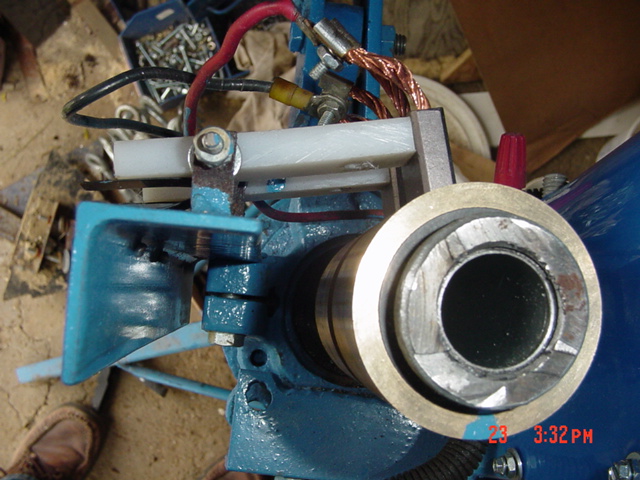My first attempts were with copper connectors that you would connect 2 lengths of 1 1/2 inch together with. They got better as time went on, trying different brushs,holders and springs. I had a good working model for up to 200-300 watts. I am still servicing a 250 watt machine at a cottage, 90 miles from a hydro pole and the sliprings and brushes are still operational after 8 years. I clean them with emery cloth and put on some electrical grease each time I,m in the area,usually once or twice a year.
When I started building Hugh,s 8 foot 500 watt I used the same sliprings for about a month. They got black quickly and in a storm with the brake on, it actually caught on fire. The sliprings got so hot they melted the insulator that they were mounted on. The insulation burned ,along with the short wires to where they were connected to the #2 mainlead wires. I spent probably months trying different idea,s until I came up with what I,m using now. I have near 2 dozen 500-1000 watt machines around the countryside. I am using the same sliprings and brushes on my 18 foot diameter Dual Rotor,except I am running 2 brushes on each slipring and I have a spot to add the 3rd set of brushes if needed.

The neg wire comes out of the hole in the coupling under the bottom slipring. This is a new machine and you can see the tiny holes drilled on the bottom edge of the lower slipring. This is where I attach the neg wire that goes to my batterys with a robust terminal and a healthy metal screw. This wire # 6 is only going 5 feet through the mast pipe, where I will connect it to #1 and then to the batterys. The metal screw must be short so it does not go through the high tempature insulated sleeve that lines the inside of the slipring. Outherwise it would short to generator ground. I bring the positive lead up the center of the mast pipe, out the top, to the top slipring and connect it to the top lip of the same.

You can see the red positive wire that attaches to the top brush and the black wire below that attaches to the lower brush. Of course these red and black wires are going to the rectifiers which are mounted within a foot away.
The sliprings are made at a local machine shop, the brushes are starter brushes and available at a local auto shop,and so the springs. I make my own mounts from angle iron and weld on mounting tabs for the brush holders. I cut the brush holders out of 5/8 inch thick teflon sheet.
Someone asked if the cover on the generator was off a washing machine, well thats a no. I purchase all my magnet wire from a commercial winding firm and that sells me ends of rolls. In this case they buy thier wire in 100 lb buckets and I get whats left in the bucket. Some buckets Ive got, had 22 pounds in it. I went to school with the guy and he charges me 3.00 a pound. And I use the buckets to make a weatherproof shelter for my generators.
All my generators have yaw bearings. Check out my files for more pictures. Mitcamp